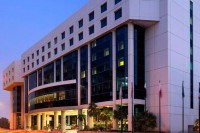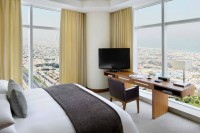Venue & Hospitality
JW Marriott Hotel Dubai Abu Baker Al Siddique Road, Hamarain Centre Deira | PO Box 16590 | Dubai | UAE
Conference Dates: September 28-29, 2017
Hotel Services & Amenities
- Audio/Visual Equipment Rental.
- Business Center.
- Business Phone Service.
- Complimentary Printing Service.
- Express Mail.
- Fax.
- Meeting Rooms.
- Office Rental.
- Photo Copying Service.
- Secretarial Service.
- Telex.
- Typewriter.
- Video Conference.
- Video Messaging.
- Video Phone.
- ATM.
- Baggage Storage.



Transportation
Driving Directions to
- Take E11, Oud Metha Rd/E66, Al Asayel Rd and Al Abraj St to your destination
- Slight left towards Airport Rd/D89 to 130 m
- Slight left towards Airport Rd/D89 to 200 m
- Merge onto Airport Rd/D89 to 400 m
- Merge onto D70 to 800 m
- Keep right at the fork to continue towardsE11 to 130 m
- Keep left at the fork, follow signs forE11/Jabel Ali and merge onto E11 to 3.9 m
- Take the exit towards Oud Metha Rd/E66 to 350 m
- Exit onto Al Asayel Rd
- Merge onto Al Asayel St to 290 m
- At the roundabout, take the 2nd exit onto Al Abraj St to 1.7 m
- Destination is at 99 m
Route Map
About City
Dubai is a city in the United Arab Emirates, located within the emirate. The emirate of Dubai is located on the southeast coast of the Persian Gulf and is one of the seven emirates that make up the country. It has the largest population in the UAE (2,106,177) and the second-largest land territory by area (4,114 km2) after Abu Dhabi. It is one of the few cities in the world that has undergone such a rapid transformation - from a humble beginning as a pearldiving centre - to one of the fastest growing cities on Earth.
Dubai today is a tourism, trade and logistics hub and has earned itself the reputation of being the ‘gateway between the east and the west’. It is also considered as the dynamic nucleus of the Arabian Gulf region.
Dubai has a fascinating history and a vibrant heritage that provides visitors an intriguing glimpse into Arabian culture. A place to start exploring the heritage and history of Dubai is the Dubai Museum: its located inside the Al Fahidi Fort, one of the Dubai’s oldest building dating back to 1787. There are other museums in Dubai that also offer insights into the history and growth of the city and of the United Arab Emirates.
Tourism is an important part of the Dubai government's strategy to maintain the flow of foreign cash into the emirate. Dubai's lure for tourists is based mainly on shopping, but also on its possession of other ancient and modern attractions. As of 2013, Dubai was the 7th most visited city of the world based on air traffic and the fastest growing, increasing by a 10.7% rate. Dubai is expected to accommodate over 15 million tourists by 2015. The emirate is also the most populous of the seven emirates of the United Arab Emirates.
Dubai has been called the "shopping capital of the Middle East". Dubai alone has more than 70 shopping centres, including the world's largest shopping centre, Dubai Mall. Dubai is also known for the traditional souk districts located on either side of its creek. Traditionally, dhows from East Asia, China, Sri Lanka, and India would discharge their cargo and the goods would be bargained over in the souks adjacent to the docks. Dubai Creek played a vital role in sustaining the life of the community in the city and was the resource which originally drove the economic boom in Dubai. As of September 2013, Dubai creek has been proposed as a UNESCO World Heritage Site. Many boutiques and jewellery stores are also found in the city. Dubai is also referred to as "the City of Gold" as the Gold Souk in Deira houses nearly 250 gold retail shops.
Dubai Creek Park in Dubai Creek also plays a vital role in Dubai tourism as it showcase some of the most famous tourist attractions in Dubai such as Dolphinarium, Cable Car, Camel Ride, Horse Carriage and Exotic Birds Shows.
Dubai has a rich collection of buildings and structures of various architectural styles. Many modern interpretations of Islamic architecture can be found here, due to a boom in construction and architectural innovation in the Arab World in general, and in Dubai in particular, supported not only by top Arab or international architectural and engineering design firms such as Al Hashemi and Aedas, but also by top firms of New York and Chicago. As a result of this boom, modern Islamic – and world – architecture has literally been taken to new levels in skyscraper building design and technology. Dubai now has more completed or topped-out skyscrapers higher than 2/3 km, 1/3 km, or 1/4 km than any other city. A culmination point was reached in 2010 with the completion of the Burj Khalifa (Khalifa Tower), now by far the world's tallest building at 829.8 m (2,722 ft). The Burj Khalifa's design is derived from the patterning systems embodied in Islamic architecture, with the triple-lobed footprint of the building based on an abstracted version of the desert flower hymenocalliswhich is native to the Dubai region. The completion of the Khalifa Tower, following the construction boom that began in the 1980s, accelerated in the 1990s, and took on a rapid pace of construction unparalleled in modern human history during the decade of the 2000s, leaves Dubai with the world's tallest skyline as of 4 January 2010. At the Top, Burj Khalifa, the world’s highest observatory deck with an outdoor terrace is one of Dubai’s most popular tourist attractions, with over 1.87 million visitors in 2013.
